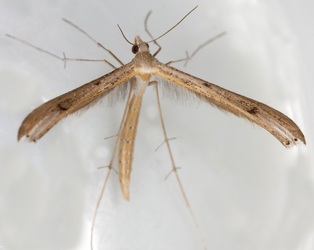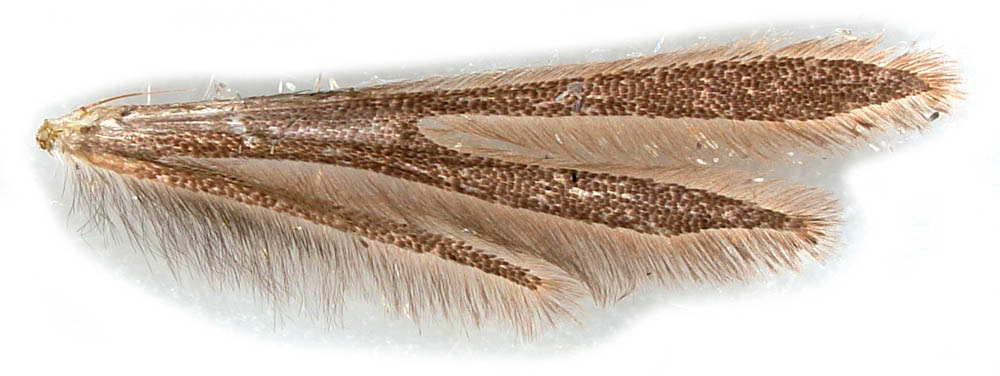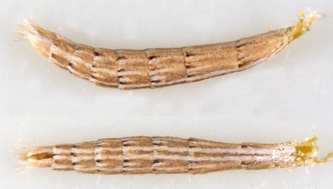45.013 Stenoptilia bipunctidactyla (Twin-spot Plume)
ws: 17-25mm; May-Oct; devil's-bit/field/small scabious (Succisa pratensis / Knautia arvensis / Scabiosa columbaria); common throughout GB
ID: The basic forewing pattern of Stenoptilia species includes the following dark markings: a discal spot; 2 spots at base of cleft, which may be confluent; a spot in the fringe at the anal angle of the 1st lobe; 2 or 3 spots in the fringe of the termen of the 2nd lobe. The following additional features may help in identifying a fresh specimen to species, but genital dissection is likely to be required for confirmation:
S.bipunctidactyla: forewing dark brown; spots at base of cleft fused, longitudinal spot in centre of 1st lobe; 2nd lobe fringe with spot at apex and in termen at 2/3 (according to Gielis, but most web images show an additional spot at anal angle).
S.pterodactyla: forewing pale red-brown to yellow-brown, dorsal margin yellowish; 2 small separate spots at base of cleft; white costal cilia (UKMoths), 2nd lobe - 2 small black spots along termen
S.annadactyla: forewing brown-grey, dorsal margin pale brown to yellowish; 2 spots at base of cleft often confluent, longitudinal spot proximal to the more costal of the 2 cleft spots, longitudinal spot in centre of first lobe; 2nd lobe fringe - 3 black spots along termen (not mentioned by Gielis but present in all specimens so-labelled). (UKMoths is confusing here as it mentions the prominence of the spot at anal angle of 1st lobe fringe as a potential distinction from S.bipunctidactyla, but in the image it indicates the black spot at the anal angle of the 2nd lobe, and the spot at the anal angle of the first lobe does not seem particularly prominent).
S.zophodactylus: forewing pale brown; the more costal of the 2 spots before base of cleft slightly proximal to the more dorsal spot; 1st lobe fringe with 2 spots at termen, 2nd lobe fringe with 2 spots in termen. UKMoths states that this is the only British member of the genus with white legs and an all-white saddle - however, on comparing plates in Gielis and web images the legs do not seem to me to be convincingly whiter than other species in the group and the whiteness of the saddle seems variable at least in comparing S.bipunctidactyla and S.zophodactylus. The presence of 1 spot in the 1st lobe fringe of S.bipunctidactyla and 2 spots in S.zophodactylus (a difference also illustrated but not mentioned in the text of UKMoths) may be a better feature.
S.aridus - indistinguishable from S.bipunctidactyla (and only separable by examination of female genitalia).
S.millieridactyla: forewing grey-brown, dorsal margin pale reddish-brown; discal spot small, double spot at base of cleft ("hardly confluent"), longitudinal spot in dorsal half of 1st lobe; 1st lobe fringe with 2 small spots in termen in addition to the 1 at anal angle, 2nd lobe fringe with basal row of black scales interrupted at 1/2 & 3/4.
S.aridus is a very rare migrant, S.islandicus is confined to the Scottish Highlands, S.annadactyla has only recently been discovered in GB and S.millieridactyla is not found in S.England - so a specimen found is S.England is most likely to be one of S.pterodactyla/bipunctidactlya/zophodactylus. On the basis of the above information the fused spot(s) at the base of the cleft and the single spot at the anal angle of the 1st lobe should make specimen §1 S.bipunctidactyla.
S.bipunctidactyla: forewing dark brown; spots at base of cleft fused, longitudinal spot in centre of 1st lobe; 2nd lobe fringe with spot at apex and in termen at 2/3 (according to Gielis, but most web images show an additional spot at anal angle).
S.pterodactyla: forewing pale red-brown to yellow-brown, dorsal margin yellowish; 2 small separate spots at base of cleft; white costal cilia (UKMoths), 2nd lobe - 2 small black spots along termen
S.annadactyla: forewing brown-grey, dorsal margin pale brown to yellowish; 2 spots at base of cleft often confluent, longitudinal spot proximal to the more costal of the 2 cleft spots, longitudinal spot in centre of first lobe; 2nd lobe fringe - 3 black spots along termen (not mentioned by Gielis but present in all specimens so-labelled). (UKMoths is confusing here as it mentions the prominence of the spot at anal angle of 1st lobe fringe as a potential distinction from S.bipunctidactyla, but in the image it indicates the black spot at the anal angle of the 2nd lobe, and the spot at the anal angle of the first lobe does not seem particularly prominent).
S.zophodactylus: forewing pale brown; the more costal of the 2 spots before base of cleft slightly proximal to the more dorsal spot; 1st lobe fringe with 2 spots at termen, 2nd lobe fringe with 2 spots in termen. UKMoths states that this is the only British member of the genus with white legs and an all-white saddle - however, on comparing plates in Gielis and web images the legs do not seem to me to be convincingly whiter than other species in the group and the whiteness of the saddle seems variable at least in comparing S.bipunctidactyla and S.zophodactylus. The presence of 1 spot in the 1st lobe fringe of S.bipunctidactyla and 2 spots in S.zophodactylus (a difference also illustrated but not mentioned in the text of UKMoths) may be a better feature.
S.aridus - indistinguishable from S.bipunctidactyla (and only separable by examination of female genitalia).
S.millieridactyla: forewing grey-brown, dorsal margin pale reddish-brown; discal spot small, double spot at base of cleft ("hardly confluent"), longitudinal spot in dorsal half of 1st lobe; 1st lobe fringe with 2 small spots in termen in addition to the 1 at anal angle, 2nd lobe fringe with basal row of black scales interrupted at 1/2 & 3/4.
S.aridus is a very rare migrant, S.islandicus is confined to the Scottish Highlands, S.annadactyla has only recently been discovered in GB and S.millieridactyla is not found in S.England - so a specimen found is S.England is most likely to be one of S.pterodactyla/bipunctidactlya/zophodactylus. On the basis of the above information the fused spot(s) at the base of the cleft and the single spot at the anal angle of the 1st lobe should make specimen §1 S.bipunctidactyla.
Male genitalia
S.bipuntidactyla: anellus arms 2/3 length of tegumen; uncus small, just exceeding margin of tegumen
S.zophodactylus: anellus arms 1/2 length of tegumen; uncus small, not exceeding margin of tegumen; tegumen with 2 membranous projections at apex
S.pterodactyla: anellus arms 2/3 length of tegumen; uncus long, exceeding margin of tegumen by just over 1/2 its length
S.millieridactyla: anellus arms 3/4 length of tegumen with clubbed apices; uncus stout and exceeding margin of tegumen by 1/2 its length
S.annadactyla: anellus arms 2/3 length of tegumen; uncus exceeding margin of tegumen by 1/2 its length
S.islandicus: anellus arms 2/3 length of tegumen; uncus exceeding margin of tegumen by 1/2 its length
S.aridus: indistinguishable from S.bipunctidactyla
S.bipuntidactyla: anellus arms 2/3 length of tegumen; uncus small, just exceeding margin of tegumen
S.zophodactylus: anellus arms 1/2 length of tegumen; uncus small, not exceeding margin of tegumen; tegumen with 2 membranous projections at apex
S.pterodactyla: anellus arms 2/3 length of tegumen; uncus long, exceeding margin of tegumen by just over 1/2 its length
S.millieridactyla: anellus arms 3/4 length of tegumen with clubbed apices; uncus stout and exceeding margin of tegumen by 1/2 its length
S.annadactyla: anellus arms 2/3 length of tegumen; uncus exceeding margin of tegumen by 1/2 its length
S.islandicus: anellus arms 2/3 length of tegumen; uncus exceeding margin of tegumen by 1/2 its length
S.aridus: indistinguishable from S.bipunctidactyla
§1 St Marys, Isles of Scilly; 30/09/2011; male; fw 9.1mm
§2 Camas-luinie, West Ross & Cromarty; 23/07/2023; female; fw 10.5mm
All images © Chris Lewis
§2 Camas-luinie, West Ross & Cromarty; 23/07/2023; female; fw 10.5mm
All images © Chris Lewis
Page published 01/04/2012 (§1) | labelling on male genital image corrected 16/11/2012 | §2 added 10/12/2023















